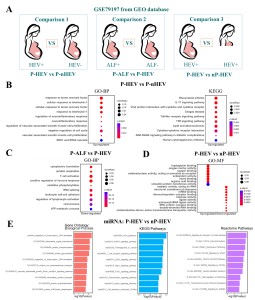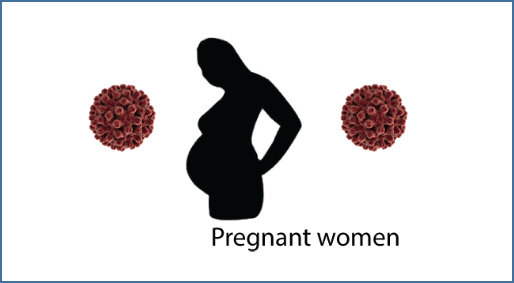Hepatitis E virus (HEV) infection in pregnant women is associated with a wide spectrum of adverse consequences for both mother and fetus. The high mortality in this population appears to be associated with hormonal changes and consequent immunological changes.
A research group led by Dr. Yijin Wang in Southern University of Science and Technology, Shenzhen, China conducted an analysis of immune responses in pregnant women infected with HEV manifesting varying severity (Figure 1). Biological functions in pregnant women with HEV infection (P-HEV) versus without HEV infection (P-nHEV), P-HEV progressing to ALF (P-ALF) versus P-HEV, and P-HEV versus non-pregnant women with HEV infection (nP-HEV) were examed.
Cellular response to interleukin-1, IL-17 signaling pathway, immune response-regulating signaling pathway were activated in P-HEV than P-nHEV. However, T cell activation, leukocyte cell-cell adhesion, regulation of lymphocyte activation and immune response-regulating signaling pathway were markedly suppressed in P-ALF compared to P-HEV. Only MHC protein complex binding function was inhibited in P-HEV compared with nP-HEV, suggesting the immunity in pregnant women was quite resemble that in general populations. Additionally, downregulated miRNAs between P-HEV and nP-HEV were significantly enriched by MAPK and T cell receptor signaling pathways. The study illuminates a robust immune activation in P-HEV and a contrasting impaired pattern of immune response in P-ALF.
In summary, immune responses were activated during HEV infection while being suppressed when developing ALF during pregnancy, heightening the importance of immune mediation in the pathogenesis of severe outcome in HEV infected pregnant women.

Figure 1. Deregulation of immune response contributing to fulminant hepatitis in HEV infected pregnant women. (A) Transcriptome expression profiles from dataset GSE79197. (B) The enrichment bubble diagrams of DEGs from “P-HEV versus P-nHEV” comparison. (C) The enrichment bubble diagram of DEGs from “P-ALF versus P-HEV” comparison. (D) The enrichment bubble diagram of DEGs from “P-HEV versus nP-HEV” comparison. (E) The enrichment bar diagrams of DE miRNAs from “P-HEV versus nP-HEV” comparison.
Read the full article (J Med Virol. 2024 May;96(5):e29639.): DOI: 10.1002/jmv.29639

